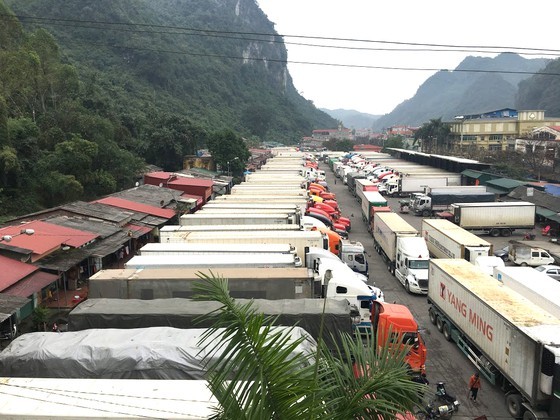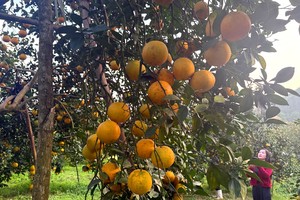
According to Mr. Nguyen Quoc Toan, Director of the Agro Processing and Market Development Authority under the MARD, since last year, the export of Vietnamese agricultural products, including vegetables and fruits, to China has become more difficult. At the border between Vietnam and China, the latter had put up fencing to prevent cross-border trade, it even used fly-cams for supervision. Meanwhile, many vegetables and fruits of Vietnam have not been able to be officially exported but mainly through cross-border trade, causing agricultural products of Vietnam to keep stagnant at the border gates.
The Import-Export Department under the MoIT also said that the annual export activities to China through Northern border provinces are usually vibrant before and after the lunar New Year.
Despite the effort of local authorities, the congestion of agricultural products at the border gates in the North during peak season continues to recur. This issue cannot be solved if there is no synchronous and long-term measure, from the stage of production organizing, processing, packing to forwarding and exporting; from the state management authorities to product line associations and enterprises.
Therefore, the MoIT has recently announced the export situation of agricultural products and fruits to the Chinese market on the occasion of lunar New Year, asking enterprises, farms and farmers to closely monitor the developments of customs clearance to ensure the quality of their products and the rate of export progress.
Of which, the ministry ordered enterprises to closely watch the developments of export activities of agro-aquatic products in general and fruits in particular through Northern border provinces, such as Lang Son, Lao Cai, Quang Ninh and Cao Bang, to actively make plans for production and packing to meet the requirements of the importing country; timely adjust the progress of transporting and forwarding goods at the border gates when unusual congestion happens.
Enterprises had better to actively classify and select the types of farm produce and fruits and pack them right at the production sites, meeting the requirements of importing partners on specifications, quality, label and packing, before transporting their goods to the border region; strictly follow the regulations about traceability and declaration of production and packing facilities as agreed with the importing country.
According to Mr. Toan, to improve export efficiency, cooperation amongst ministries and departments is crucial, ensuring synchronism and consistency to timely adjust and minimize the possible congestion at border region during this peak season, avoiding causing losses to enterprises and farmers.
At key farming areas, as well as agro-aquatic associations, it is necessary to frequently review production activities, adjust crop production, consisting of growing area, productivity, production and quality, and reasonably adjust agricultural product supply this year.
The Import-Export Department discussed with the departments of Industry and Trade of Northern border provinces to update and publicize information about the developments of customs clearance, the export situation of agricultural products, food and fruits in the province before and after lunar New Year for enterprises and farmers.
The MoIT has been collaborating with the Ministry of Finance and the Ministry of Transport to organize channeling at border region, speeding up construction progress of logistics infrastructure, such as a cold storage in Tra Linh District in Cao Bang Province, transshipment area in Lang Son Province, and a depot in Bac Giang Province; at the same time, persuade Chinese authorities to open more border gates designated for importing agricultural products and fruits at border region.
Up to now, only nine products have been exported officially to China. The MARD is going to China to negotiate official export for products, including durians, passion fruits, sweet potatoes and grass jelly in May this year.
In the long term, to maintain market share and expand market in China, the MoIT suggested that enterprises need to increase awareness of solidarity, coordination and interest harmonization to deal with price squeezing in trading across the border with Chinese enterprises; change the mindset about market access, transaction method, production organization and exporting of agricultural and aquatic products to China; build long-term plans and business strategies with Chinese enterprises; increase development of brands, designs and packing, improving trade skills and lingual knowledge to correctly meet the requirements and the taste of the market.
The Import-Export Department under the MoIT also said that the annual export activities to China through Northern border provinces are usually vibrant before and after the lunar New Year.
Despite the effort of local authorities, the congestion of agricultural products at the border gates in the North during peak season continues to recur. This issue cannot be solved if there is no synchronous and long-term measure, from the stage of production organizing, processing, packing to forwarding and exporting; from the state management authorities to product line associations and enterprises.
Therefore, the MoIT has recently announced the export situation of agricultural products and fruits to the Chinese market on the occasion of lunar New Year, asking enterprises, farms and farmers to closely monitor the developments of customs clearance to ensure the quality of their products and the rate of export progress.
Of which, the ministry ordered enterprises to closely watch the developments of export activities of agro-aquatic products in general and fruits in particular through Northern border provinces, such as Lang Son, Lao Cai, Quang Ninh and Cao Bang, to actively make plans for production and packing to meet the requirements of the importing country; timely adjust the progress of transporting and forwarding goods at the border gates when unusual congestion happens.
Enterprises had better to actively classify and select the types of farm produce and fruits and pack them right at the production sites, meeting the requirements of importing partners on specifications, quality, label and packing, before transporting their goods to the border region; strictly follow the regulations about traceability and declaration of production and packing facilities as agreed with the importing country.
According to Mr. Toan, to improve export efficiency, cooperation amongst ministries and departments is crucial, ensuring synchronism and consistency to timely adjust and minimize the possible congestion at border region during this peak season, avoiding causing losses to enterprises and farmers.
At key farming areas, as well as agro-aquatic associations, it is necessary to frequently review production activities, adjust crop production, consisting of growing area, productivity, production and quality, and reasonably adjust agricultural product supply this year.
The Import-Export Department discussed with the departments of Industry and Trade of Northern border provinces to update and publicize information about the developments of customs clearance, the export situation of agricultural products, food and fruits in the province before and after lunar New Year for enterprises and farmers.
The MoIT has been collaborating with the Ministry of Finance and the Ministry of Transport to organize channeling at border region, speeding up construction progress of logistics infrastructure, such as a cold storage in Tra Linh District in Cao Bang Province, transshipment area in Lang Son Province, and a depot in Bac Giang Province; at the same time, persuade Chinese authorities to open more border gates designated for importing agricultural products and fruits at border region.
Up to now, only nine products have been exported officially to China. The MARD is going to China to negotiate official export for products, including durians, passion fruits, sweet potatoes and grass jelly in May this year.
In the long term, to maintain market share and expand market in China, the MoIT suggested that enterprises need to increase awareness of solidarity, coordination and interest harmonization to deal with price squeezing in trading across the border with Chinese enterprises; change the mindset about market access, transaction method, production organization and exporting of agricultural and aquatic products to China; build long-term plans and business strategies with Chinese enterprises; increase development of brands, designs and packing, improving trade skills and lingual knowledge to correctly meet the requirements and the taste of the market.
























